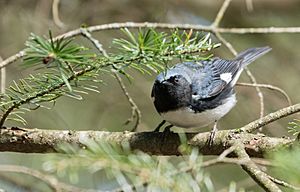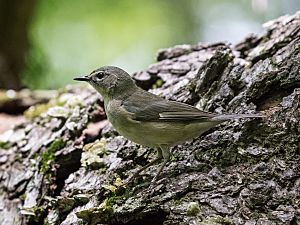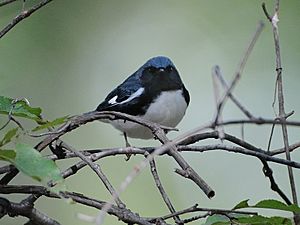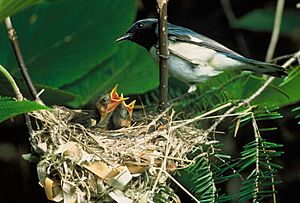Black-throated blue warbler facts for kids
Quick facts for kids Black-throated blue warbler |
|
|---|---|
 |
|
| Male | |
| Conservation status | |
| Scientific classification | |
| Genus: |
Setophaga
|
| Species: |
caerulescens
|
 |
|
| Range of S. caerulescens Breeding range Wintering range | |
| Synonyms | |
|
Dendroica caerulescens |
|
The black-throated blue warbler (Setophaga caerulescens) is a small passerine bird. It belongs to the New World warbler family. These birds live and raise their young in forests in eastern North America.
When the weather gets cold, they migrate to warmer islands in the Caribbean and Central America. Sometimes, they are seen in western Europe, but this is very rare. Male and female black-throated blue warblers look quite different. The adult male has a black face, blue back, and white belly. The female is olive-brown on top and light yellow underneath.
Black-throated blue warblers mainly eat insects. In winter, they also eat berries and seeds. They build their nests in thick bushes, close to the ground. This makes them easy for scientists to study. These warblers protect their nesting and winter homes from other warblers. Because they need large, untouched forests to nest, their numbers are slowly going down.
Contents
About the Black-throated Blue Warbler
The black-throated blue warbler was first described in 1789 by a German scientist named Johann Friedrich Gmelin. Its scientific name, caerulescens, is a Latin word meaning "turning blue."
This bird is part of the New World warbler family, called Parulidae. It used to be in a group called Dendroica. But in 2010, scientists studied their DNA. They found that this warbler, and many others, should be moved to the group Setophaga.
These birds breed in North America and spend winter in the Caribbean. Scientists have noticed that warblers from northern areas of North America look a bit different and travel to different islands than those from southern areas. For example, northern birds often winter in Cuba and Jamaica. Southern birds usually go to Hispaniola and Puerto Rico. Also, males from the south have darker feathers. Even with these differences, recent studies show that the birds are still very similar genetically. This means the differences probably appeared quite recently.
What Does It Look Like?

The black-throated blue warbler is about 13 cm (5.1 in) long. It weighs between 8.4–12.4 g (0.30–0.44 oz). Its wings can spread out about 7.5 to 7.9 inches (19-20 cm). Males and females look very different, which is called sexual dimorphism.
The adult male has a black throat, face, and sides. Its belly is white, and its upper body is a deep blue. Young males look similar but have greener upper parts. The female has olive-brown upper parts and light yellow underparts. Her wings and tail are darker, and she has a gray head and brown patches on her cheeks. Both male and female birds have a thin, pointed beak. They also have small white patches on their wings, but these are not always easy to see.
Like many warblers, their feathers are very colorful in spring and summer. But after the breeding season, their colors become duller. In the fall, you can still spot them by their small white wing patches. Young birds have brown upper parts and creamy stripes above their eyes. They also have brownish spots on their throat, chest, and belly.
The male's song sounds like a buzzing zee-zee-zeeee that goes up at the end. Their call is a flat ctuk.
Where Do They Live?
The black-throated blue warbler is a bird that migrates. It breeds in mature deciduous forests or mixed forests with lots of thick bushes. You often find them in hilly and mountainous areas in the northeastern United States and southeastern Canada.
In late summer, they fly to tropical forests and scrublands in the Greater Antilles for the winter. During their long journey, you might see them in places like parks and gardens.
Choosing a safe nesting spot is very important for these birds. They build their nests close to the ground. So, they need a protected place where predators are less likely to find their eggs and young.
How Do They Behave?
Eating and Finding Food
The black-throated blue warbler actively searches for food in low plants. Sometimes, it hovers in the air or catches insects while flying. It often stays in one area to find food before moving to another spot. They mostly eat invertebrates like caterpillars, crane flies, and spiders. In winter, they might also eat seeds, berries, and fruit.
Males and females look for food in different places. Males usually hover among the higher branches of bushes, between 3 and 9 m (9.8 and 29.5 ft) off the ground. Females tend to look for food closer to the ground. As the breeding season goes on, males will also come down to lower levels to find food for their fledglings.
These warblers mostly find food in the lower parts of the forest, called the understory, not high up in the tree canopy. The large leaves and long branches in the understory affect how they hunt. They often hover to catch prey because it's harder to pick insects off leaves in such thick growth.
Raising Young
The black-throated blue warbler is a monogamous bird, meaning a male and female usually stay together for the breeding season. Their breeding season is usually from May to July. The male sings a soft song to attract a female. He then follows her as she looks for food or a place to build a nest. When the female rests, the male will slightly drop his wings, stretch his head forward, open his beak, and face her. The female might also vibrate her wings. Then, the male will briefly mate with the female before flying off.
Studies show that these warblers prefer to live in hardwood forests with many bushes. These areas usually have more food. In these places, there are more warblers, and the birds are often older, at least two years old.
Warblers also use clues from other birds to choose their nesting spots. They listen to the songs of other males after the breeding season. Males who have successfully raised young continue to sing. Males who failed usually leave the area. So, these songs tell other birds if a habitat is good for raising young. This is a quick and easy way for birds to find a good home, showing how important social communication is for their survival. Females, however, seem to decide on nesting sites based on whether males are present.
Mating with Other Birds
Even though black-throated blue warblers usually stay with one partner, males are sometimes seen in other males' territories. This suggests that birds sometimes mate with partners outside their main pair. Studies have shown that when this happens, the other parent is often a male from a nearby territory.
Males try to guard their mates when the females are most likely to mate. They stay close to their partner, singing softly and following her as she looks for food or a nest site. This guarding behavior can make it harder for males to find other mates themselves. Studies show that if a male is removed, there's a higher chance of the female's offspring having a different father. This means mate guarding helps reduce mating with other birds. However, it doesn't stop it completely.
Females who mate with other birds might get better genes for their offspring. But they might also get less help from their main partner in raising the young. So, mating with other birds can have costs for females too. One idea is that females choose mates with very different genes from their own. This can help their offspring have stronger immune systems.
Current Situation and Dangers
The black-throated blue warbler has a large population and lives across a wide area. Its numbers are currently growing. Because of this, the IUCN (a group that tracks species) listed it as Least Concern in 2012. This means it's not currently in danger of disappearing.
However, cutting down forests and breaking up habitats are threats in their tropical winter homes. A report from 2000 looked at how global warming affects these birds. It studied the impact of El Niño (a warm ocean phase) on their survival. During El Niño years, fewer adult birds survived in their wintering grounds in Jamaica. They also had fewer young in their breeding areas in New Hampshire. Fewer young birds also returned to both their breeding and wintering grounds.
During La Niña years (a cold ocean phase), when the weather was wetter and there was more food, all these factors were better. Long-term global warming could make the effects of El Niño even worse. This could cause the black-throated blue warbler population to change more.
See also
 In Spanish: Reinita azulada para niños
In Spanish: Reinita azulada para niños




